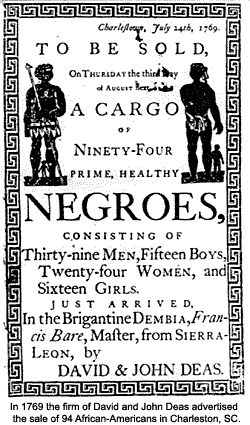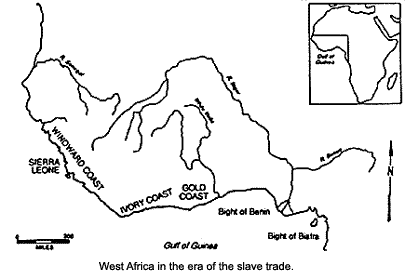South Carolina  SC African-Americans
SC African-Americans  Understanding Slavery
Understanding Slavery  African Slave Trade and South Carolina
African Slave Trade and South Carolina
South Carolina and the African Slave Trade
Slavery was well established in the "New World" by the Spanish, Portuguese, and Dutch, who all sent African slaves to work in both North and South America during the late sixteenth and early seventeenth centuries. The English began aggressively trading in what was called
"black ivory" during the middle of the seventeenth century, spurred on by the need for laborers in the hot, humid sugar fields on the West Indian islands of Barbados, St. Christopher, the Bermudas, and Jamaica.
By the time Charles Towne was settled in 1670, Englishmen from the West Indies were well acquainted with slavery and the huge profits they could reap from the toil of others.
Slavery was therefore considered an essential ingredient in the successful establishment of cash crop plantations in South Carolina.
Like other European nations, England created the
Royal African Company to underwrite the slave trade. A string of forts and "slave factories" were established from the Cape Verde Islands to the Bight of Biafra. But the slave trade would likely not have been as "successful" were it not for the "unholy alliance" between the English (and other European nations) and the African kingdoms on whose territories the forts stood.
The English slave traders did their best to dupe the native kings, and each native king did his best to obtain the maximum amount of goods in exchange for the slaves he had for sale.

For their cargoes of human flesh, the traders brought iron and copper bars, brass pans and kettles, cowrey shells, old guns, gun powder, cloth, and alcohol. In return, ships might load on anywhere from 200 to over 600 African slaves, stacking them like cord wood and allowing almost no breathing room. The crowding was so severe, the ventilation so bad, and the food so poor during the
"Middle Passage" of between five weeks and three months that a loss of around 14 to 20% of their "cargo" was considered the normal price of doing business. This slave trade is thought to have transported
at least 10 million, and perhaps as many as 20 million, Africans to the American shore.
The slave traders discovered that Carolina planters had very specific ideas concerning the ethnicity of the slaves they sought. No less a merchant than Henry Laurens wrote:
The Slaves from the River Gambia are preferr'd to all others with us [here in Carolina] save the Gold Coast.... next to Them the Windward Coast are preferr'd to Angolas.
In other words, slaves from the region of Senegambia and present-day Ghana were preferred. At the other end of the scale were the "Calabar" or Ibo or "Bite" slaves from the Niger Delta, who Carolina planters would purchase only if no others were available. In the middle were those from the Windward Coast and Angola.
Carolina planters developed a vision of
the "ideal" slave – tall, healthy, male, between the ages of 14 and 18, "free of blemishes," and as dark as possible. For these ideal slaves Carolina planters in the eighteenth century paid, on average, between 100 and 200 sterling – in today's money that is between $11,630 and $23,200!
Many of these slaves were almost immediately put to work in South Carolina's
rice fields. Writers of the period remarked that there was no harder, or more unhealthy, work possible:
negroes, anckle and even mid-leg deep in water which floats an ouzy mud, and exposed all the while to a burning sun which makes the very air they breathe hotter than the human blood; these poor wretches are then in a furness of stinking putrid effluvia: a more horrible employment can hardly be imagined.
In fact, these Carolina rice fields have been described as charnel houses for African-American slaves.
Malaria and enteric diseases killed off the low country slaves at rates which are today almost unbelievable. Based on the best plantation accounts it is clear that while about one out of every three slave children on the cotton plantations died before reaching the age of 16,
nearly two out of every three African-American children on rice plantations failed to reach their sixteenth birthday and over a third of all slave children died before their first birthday. Rice's macabre record of slave deaths has been traced to two primary factors - one was malaria, the other was the infants' feebleness at birth, probably the result of the mothers' own chronic malaria and their general exhaustion from rice cultivation during pregnancy.
After their horrific "Middle Passage," over 40% of the African slaves reaching the British colonies before the American Revolution passed through South Carolina. Almost all of these slaves entered the Charleston port, being briefly quarantined on Sullivan's Island, before being sold in Charleston's slave markets.
Once in South Carolina what was the lives of these slaves like? How did they live? What did they eat? What did their houses look like? How did they prepare their food? What kinds of possessions did they have? What did their pottery look like? White masters had little or no interest in recording these details for future generations. Slavery was an economic issue and the only details worthy of being consistently recorded were those related to the value of their slaves or
the value of their production. The daily lives of these new African-Americans was probably poorly understood and certainly of little importance to the planters. These are all questions that can only be answered through archaeology.

